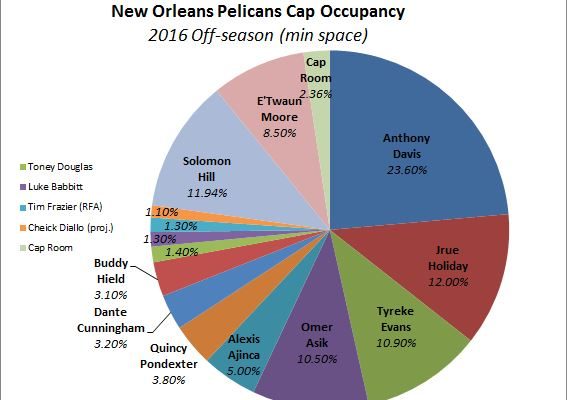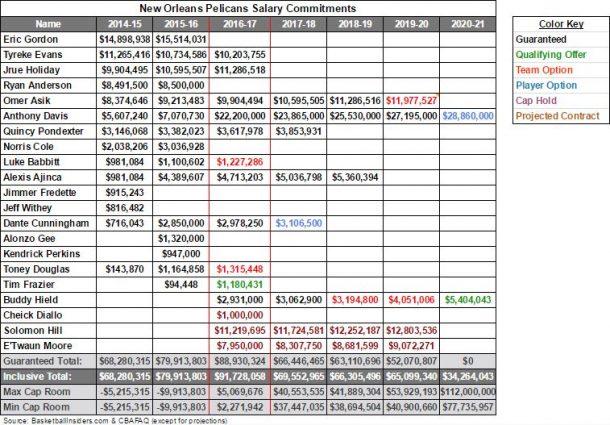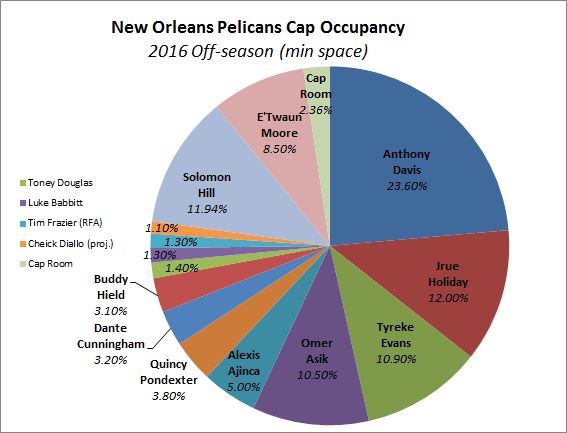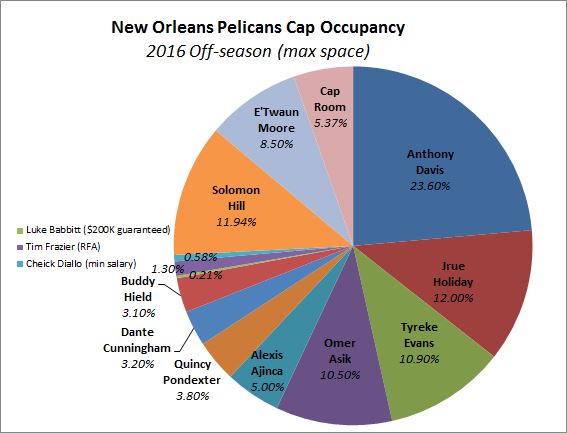« Pelicans agree to terms with E’Twaun Moore
A Snapshot of the Pelicans’ Transforming Roster

About a year ago today, I wrote a column discussing the ramifications for the Pelicans of the coming cap jump in the 2016 off-season. That time is now here, and boy, things are getting crazy. So where does New Orleans stand regarding this off-season from a salary cap perspective?
Heading into free agency, the Pelicans were sitting at around $21-22 million in cap room, with the ability to move that number up to close to $25 million based on decisions related to Toney Douglas, Luke Babbitt, and Cheick Diallo (I’ll explain more about that in a bit). As of late last night, the Pelicans have verbally agreed to terms with Pacers forward Solomon Hill and Bulls guard E’Twaun Moore on four-year contracts worth a total of $48 million and $34 million respectively. The impact from a cap perspective can be seen via the table below (spreadsheet updated from last summer; note that prior years ignore minor elements such as 10-day contracts and the like):

First of all, it is important to note that the max and min cap room numbers at the bottom are rough estimates that likely is not exactly correct because of the following two variables:
- Second round pick Cheick Diallo. While first round pick Buddy Hield is a virtual lock to retain, second round picks are typically far less certain. That being said, given the price that the Pelicans paid to acquire Diallo (packaging the 39th and 40th picks to move up to 33), this table assumes that he will be on the 15-man roster, eating up a bit of cap space for both the max and min scenarios.
- Solomon Hill and E’Twaun Moore’s contract structure. We know the terms and amounts for which both players signed, but we don’t yet know how they will both be structured. At this point, the Pelicans are likely to go one of two routes: 4.5% raises (shown in the table above) or a flat annual salary. The latter would drop the Pelicans’ max and min cap space by about $1.3 million – ~$780K for Hill and ~$550K for Moore. New Orleans will decide on which route to take likely based on how the rest of free agency plays out; if they determine that $1.3M isn’t needed, they could go with flat deals and save about that much space in year 4.
Now that we have the unknowns explained, let’s dig into the two main reasons why the Pelicans have a “range” of potential cap space.
- Toney Douglas and Luke Babbitt’s team options. If the Pelicans waive Douglas and/or Babbitt by July 12th, the team will incur a cost of $0 and/or $200K respectively for doing so. If they keep both, they will owe them $1.3 million and $1.2 million respectively.
- Cheick Diallo’s starting salary. As an estimate, I have $1 million as a place-holder, but it could be anywhere from the league minimum to even a bit more than $1 million.
Lastly – now that we know how much space the Pelicans have left and why – what can they do with it?
- Re-sign Tim Frazier. The most logical thing that the Pelicans can do is make sure that they bring back Frazier, a player who showed real promise down the stretch last season. New Orleans can gauge his market, and they can offer him their remaining cap space plus the hold in place for his qualifying offer – so, anywhere from around $3.5M to $6M, depending on the factors I laid out above. They’ll still have the room mid-level exception ($2.9 million) to use as well, which could be a way to bring back James Ennis in this scenario.
- Keep exploring the free agent market for potential value signings. Signing Frazier/Diallo and bringing back one (or both) of Douglas and Babbitt would be totally reasonable, but that doesn’t mean the Pelicans should just do that and call it a day. If the Pelicans find a player who they think could be more valuable than Frazier, they could use that cap space elsewhere, or even try to move (or *gulp* stretch) Tyreke Evans if they get a can’t miss opportunity that requires more cap room.
Now that we have the variables laid out – many of you are probably saying “holy crap, that’s a lot of money for a couple of guys who I don’t know much about!” I’ll let my Bourbon Street Shots colleagues get into why the deals are reasonable from an on-court perspective, but let’s first talk a bit about why it makes sense financially.
As we all know, the salary cap just went up this summer. WAY up. An unprecedented 35% increase, from $70 million to $94 million. So, there is a lot of money to be paid to a smaller subset of the league’s players who happen to be free agents right now. Even for some analysts and writers whose jobs it is to cover the NBA, it is tough to fully grasp the impact of the new cap environment. I have found that the best way to transition from last season to this one is by looking at players’ salaries as a percentage of the cap rather than raw dollars. The below pie charts do so for the Pelicans’ the min and max cap space scenarios:


Suddenly, the picture looks more reasonable, right? Compare these percentages with 2015-16, when Eric Gordon was making over 22% of the salary cap and Omer Asik was at over 13% (not terribly high, but still higher than any one Pelicans player today apart from Anthony Davis). Salaries may be higher than ever before, but remember that league revenue is the main driver of the league salary cap, so it only makes sense that the players would benefit.
Any other questions? Leave them in the comments or tweet me @MasonGinsberg and I’ll be happy to answer them. (You can also reach out to Jason Calmes, who knows far more about the NBA collective bargaining agreement than I do.)





5 Comments